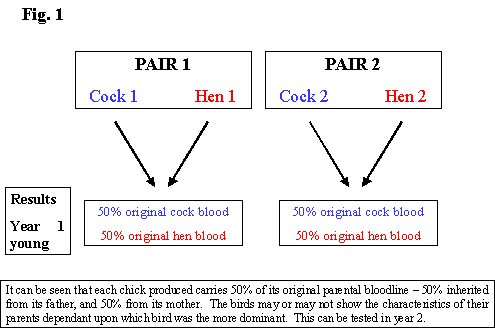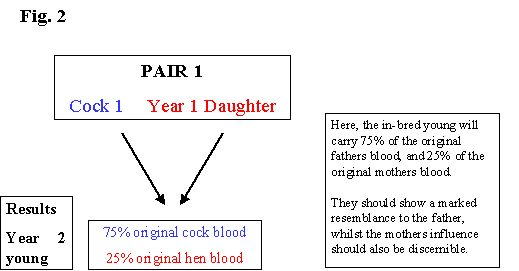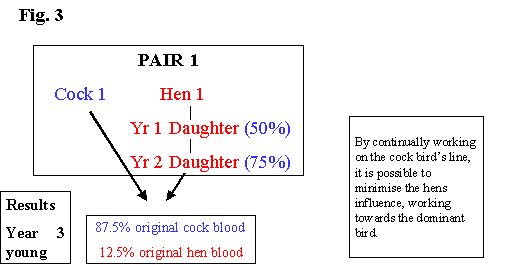PERFECTING TRUE LINES
BRIAN KEENAN explains the logic of line breeding, including how to single out desirable characteristics using line and in-breeding genetics, with the aim of producing true-breeding birds. Most serious canary fanciers accept that the quickest way to establish a winning stud, which can in turn produce high quality young, is by line breeding. The question is: how to go about it.
If you take the example of a new fancier entering the hobby, most established breeders recommend starting with two pairs of birds. Ideally these have all been obtained from the same breeder, and so are already related, at least distantly. When line breeding, the important thing is to remove any foreign genes, so that more predictable results are obtained, and you can realistically work at improving your stock during each progressive breeding season.
The results are shown below:
The above mating, assuming the original cock is true breeding, will produce birds which resemble their father, modified slightly because of the original mother birds influence on the pairing. If the results are markedly different, then the cock is not true breeding, and can be discarded from the breeding program.
You do have a second option of pairing brothers and sisters together, but this would not add to the genetic influence of any birds produced, as they would retain 50% of the original parental gene pool. It would however, produce birds of similar worth to their immediate parents, as far as the stud line is concerned. Fanciers talk of 'locking-in' or 'fixing' points within a stud, generally referring to in-breeding. Remember that you are not only fixing strong points, but also weak points at the same time, so be very careful how you use any resulting young, if you proceed along that particular route. In-breeding is extremely useful when you need to prove the dominance of a particular bird, or if you need to re-create a specific bird, for example if the original bird is getting beyond breeding age, but still has a powerful influence on your stud.
A third option available to you in your second year, is to cross mate the young from your original pair 1 to either the original pair 2 parents, or into the young produced from pair 2. This is why it is best to obtain all your birds from one initial source, as you are now extending the gene pool from which you are working. This is in fact an outcross, but introduced in a controlled manner.
The reason you may wish to pair this way is to introduce some desired point that is apparent throughout your second line, to strengthen your first line. Pairing a son from line 1 to a daughter from line 2, perhaps to introduce say better legs into line 1, would retain 25% of the original cock and 25% of the original hen blood, modified by the parental stock in line 2. Ideally, this second line contains similar good points to those possessed by your line 1 birds, and in addition, carries the added feature you are looking for.
It is pointless using birds which do not match the strengths of your existing line, as a mixed bag of young are certain to be produced, and you want to enhance the line the following season, rather than hasten it's decline.
From this cross, it is important to remember that you are looking for only one specific young bird - one that is compatible with your first line, but excels in the added feature you wish to adopt. If your in-breeding matings (see Fig 2 above) have proven that the original cock bird is dominant, then you are looking for a compatible hen, or vice-versa, and all other birds produced should be discarded.
It is worth pointing out here that experience fanciers tend to pair cock birds to two or more hens in the first year. This enables them through experience, to assess the quality of young produced in comparison with their father, and determine without the need for in-bred test matings, whether to continue to develop their stud around the cock bird, or not. As well as in-breeding in year 2, they are also able to pair half brothers and half sisters, and develop their line much more quickly, as a result.
By pairing the original cock bird into one of his Year 2 daughters who herself carries 75% of his blood, the result is a nest of birds which carry 87.5% of the original fathers bloodline. They have been enhanced slightly, or there is little point in following this route, by the original mothers influence, but they have been produced to retain and maximise the cock birds characteristics. If he was an exceptional showbird - then everything being equal, so should they be - and you will have arrived!
Remember that you can line breed and in-breed for any desirable point or
characteristic, whether that is length, shoulder, head qualities,
feeding, fertility, vitality, or any other point you require. Unlike
genetic engineers, canary breeders are unable to single out individual
genes, but they can produce true breeding birds, if proceeding down the
line breeding route.
One final point about line breeding. By choosing your original stock wisely, you minimise the need to obtain additional birds in any great numbers, assuming you achieve average success in the breeding room. Even if that is the case, the developing fancier is wise to go back to his original source regularly, for a single bird each year, which itself has been bred from the same source line of birds. It will fit your line, and will contain the points you are currently developing, therefore acting as a controlled outcross, and adding to the line you are developing, rather than taking anything away. After all, if you went to a successful breeder, he will have retained his better birds for his own use, so by revisiting him, you are playing to the studs strengths, which will immediately benefit your own birds.
The alternative, is to pair breed on face value only, having obtained birds from different sources, which are not related in any way.
These birds will produce haphazard results at best, and introduce many undesirable features, which you will have no chance of controlling, and which will continue to be unpredictable, year after year. Line breeding offers a progressive route forward, which most serious fanciers practice to the best of their abilities, as they go about producing and enhancing their studs.
Ask any top champion you choose - the answer is likely to be the same - they line breed to help ensure their continued success.
Source : http://www.yccuk.com/
BRIAN KEENAN explains the logic of line breeding, including how to single out desirable characteristics using line and in-breeding genetics, with the aim of producing true-breeding birds. Most serious canary fanciers accept that the quickest way to establish a winning stud, which can in turn produce high quality young, is by line breeding. The question is: how to go about it.
If you take the example of a new fancier entering the hobby, most established breeders recommend starting with two pairs of birds. Ideally these have all been obtained from the same breeder, and so are already related, at least distantly. When line breeding, the important thing is to remove any foreign genes, so that more predictable results are obtained, and you can realistically work at improving your stock during each progressive breeding season.
Figure 1
shows how our initial pairings would work. |
Second Year pairing options.
Year 2 provides several opportunities. Assuming that a reasonable number of compatible young birds have been produced, it is possible to pair in several different ways. Pair 1 parents can be paired to their sons and daughters, similarly with pair 2. This is a much closer form of line breeding known as in-breeding. It is used to determine which parents are dominant over the strain.The results are shown below:
 |
The above mating, assuming the original cock is true breeding, will produce birds which resemble their father, modified slightly because of the original mother birds influence on the pairing. If the results are markedly different, then the cock is not true breeding, and can be discarded from the breeding program.
You do have a second option of pairing brothers and sisters together, but this would not add to the genetic influence of any birds produced, as they would retain 50% of the original parental gene pool. It would however, produce birds of similar worth to their immediate parents, as far as the stud line is concerned. Fanciers talk of 'locking-in' or 'fixing' points within a stud, generally referring to in-breeding. Remember that you are not only fixing strong points, but also weak points at the same time, so be very careful how you use any resulting young, if you proceed along that particular route. In-breeding is extremely useful when you need to prove the dominance of a particular bird, or if you need to re-create a specific bird, for example if the original bird is getting beyond breeding age, but still has a powerful influence on your stud.
A third option available to you in your second year, is to cross mate the young from your original pair 1 to either the original pair 2 parents, or into the young produced from pair 2. This is why it is best to obtain all your birds from one initial source, as you are now extending the gene pool from which you are working. This is in fact an outcross, but introduced in a controlled manner.
The reason you may wish to pair this way is to introduce some desired point that is apparent throughout your second line, to strengthen your first line. Pairing a son from line 1 to a daughter from line 2, perhaps to introduce say better legs into line 1, would retain 25% of the original cock and 25% of the original hen blood, modified by the parental stock in line 2. Ideally, this second line contains similar good points to those possessed by your line 1 birds, and in addition, carries the added feature you are looking for.
It is pointless using birds which do not match the strengths of your existing line, as a mixed bag of young are certain to be produced, and you want to enhance the line the following season, rather than hasten it's decline.
From this cross, it is important to remember that you are looking for only one specific young bird - one that is compatible with your first line, but excels in the added feature you wish to adopt. If your in-breeding matings (see Fig 2 above) have proven that the original cock bird is dominant, then you are looking for a compatible hen, or vice-versa, and all other birds produced should be discarded.
It is worth pointing out here that experience fanciers tend to pair cock birds to two or more hens in the first year. This enables them through experience, to assess the quality of young produced in comparison with their father, and determine without the need for in-bred test matings, whether to continue to develop their stud around the cock bird, or not. As well as in-breeding in year 2, they are also able to pair half brothers and half sisters, and develop their line much more quickly, as a result.
Year 3 pairings.
The third year in the development of a line allows you to reproduce, almost as near as genetically possible, the original parental birds, modified slightly, by minimising the effects of other birds.By pairing the original cock bird into one of his Year 2 daughters who herself carries 75% of his blood, the result is a nest of birds which carry 87.5% of the original fathers bloodline. They have been enhanced slightly, or there is little point in following this route, by the original mothers influence, but they have been produced to retain and maximise the cock birds characteristics. If he was an exceptional showbird - then everything being equal, so should they be - and you will have arrived!
 |
One final point about line breeding. By choosing your original stock wisely, you minimise the need to obtain additional birds in any great numbers, assuming you achieve average success in the breeding room. Even if that is the case, the developing fancier is wise to go back to his original source regularly, for a single bird each year, which itself has been bred from the same source line of birds. It will fit your line, and will contain the points you are currently developing, therefore acting as a controlled outcross, and adding to the line you are developing, rather than taking anything away. After all, if you went to a successful breeder, he will have retained his better birds for his own use, so by revisiting him, you are playing to the studs strengths, which will immediately benefit your own birds.
The alternative, is to pair breed on face value only, having obtained birds from different sources, which are not related in any way.
These birds will produce haphazard results at best, and introduce many undesirable features, which you will have no chance of controlling, and which will continue to be unpredictable, year after year. Line breeding offers a progressive route forward, which most serious fanciers practice to the best of their abilities, as they go about producing and enhancing their studs.
Ask any top champion you choose - the answer is likely to be the same - they line breed to help ensure their continued success.
Source : http://www.yccuk.com/
Δεν υπάρχουν σχόλια:
Δημοσίευση σχολίου